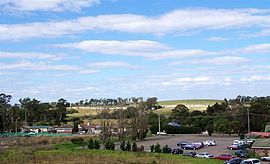Rooty Hill, New South Wales
|
Rooty Hill Sydney, New South Wales |
|||||||||||||
|---|---|---|---|---|---|---|---|---|---|---|---|---|---|

Rooty Hill, seen from the railway station. In the background is the hill from which the area gets its name.
|
|||||||||||||
| Coordinates | 33°46′18″S 150°50′38″E / 33.77167°S 150.84389°ECoordinates: 33°46′18″S 150°50′38″E / 33.77167°S 150.84389°E | ||||||||||||
| Population | 13,377 (2011 census) | ||||||||||||
| • Density | 2,123/km2 (5,500/sq mi) | ||||||||||||
| Postcode(s) | 2766 | ||||||||||||
| Area | 6.3 km2 (2.4 sq mi) | ||||||||||||
| Location | 42 km (26 mi) west of Sydney CBD | ||||||||||||
| LGA(s) | City of Blacktown | ||||||||||||
| State electorate(s) | Mount Druitt | ||||||||||||
| Federal Division(s) | Chifley | ||||||||||||
|
|||||||||||||
Rooty Hill is a suburb of Sydney, in the state of New South Wales, Australia. Rooty Hill is located 42 kilometres west of the Sydney central business district, in the local government area of the City of Blacktown and is part of the Greater Western Sydney region.
The earliest exploration of the area was led by Captain Watkin Tench in 1789. The origin of this name puzzled historians for many years because the clue lay not in Blacktown City but on Norfolk Island. Governor Philip Gidley King had been in charge of the first settlement there in early 1788 and had noted that the hillside where he had built his Government House had been difficult to dig owing to the amount of tree roots beneath the surface. The hill on Norfolk became known as Rooty Hill and the name is now official. When King returned to New South Wales he built the headquarters for his government reserve of 1802 at the foot of a hill that reminded him of the Norfolk Island Rooty Hill and used the same name. The name Rooty Hill first appeared on a map in 1803.
The early development of the area came when Captain William Minchin was given a grant of 400 hectares (1,000 acres) in 1819, leading to the development of the Minchinbury estate. Dr Charles McKay purchased the estate in 1859 and subdivided it in the 1880s. Afterwards, the Watts family built Watts Cottage in Watt Street. It combines Italianate elements with a bullnose verandah and is almost unique in the Blacktown Municipality. It is heritage-listed.
In 1890, the Imperial Hotel was built north of the railway station by F.J. Weston. It was intended to cater for the crowds who attended the greyhound racing at Lamb's Woodstock Coursing Track at Plumpton. By the early 1970s it had become semi-derelict, but was acquired by a local dentist in 1977. It reopened in 1982 and is now heritage-listed.
In 1891, the Pioneer Memorial Church, located on Rooty Hill Road South, was built on land donated by Dr Charles McKay. It was originally a Baptist church, but was later acquired for the Presbyterian community by James Angus, owner of the Minchinbury estate from 1895. It is still in use and is heritage-listed.
...
Wikipedia

